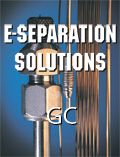HPLC Back Pressure Problem
I am facing a problem with an HPLC analysis. The flow rate is 1.3 mL/min. The solvents used are water (mobile phase A) and acetonitrile (mobile phase B). The program I run starts with 60% water and 40% acetonitrile. In 35 min the acetonitrile concentration reaches 100%.
The answer to the following question was provided by LCGC’s “LC Troubleshooting” columnist John Dolan.
Q: I am facing a problem with an HPLC analysis. The flow rate is 1.3 mL/min. The solvents used are water (mobile phase A) and acetonitrile (mobile phase B). The program I run starts with 60% water and 40% acetonitrile. In 35 min the acetonitrile concentration reaches 100%.
The problem is when I wash the column with acetonitrile the pressure is around 100 bar. As soon as equilibration starts (60% water) the pressure starts going up and reaches around 300 bar. When I inject the sample the pressure suddenly jumps around 370–380 bar. As the acetonitrile concentration increases with the advancement of the gradient program, the pressure starts coming down. Even while purging with water the pressure is around 20 bar. have sonicated the water. Once I also degassed it with vacuum, but it did not work. We don’t have a pressure-regulated sonicator. Can you suggest possible causes of this problem? How long should it be degassed under vacuum?
A:John Dolan: I don’t have sufficient information to answer the question exactly, but I can give you some estimates. I did some DryLab simulations to check for pressure. These tend to be a bit lower than observed in practice, perhaps by 25%, but they should be within a reasonable estimate. You didn't mention the column size, particle size, or temperature, all of which influence the results. But let's assume you are using a 150 mm x 4.6 mm column packed with 5-µm particles, at a temperature of 22 °C, and a flow rate of 1.3 mL/min. DryLab yields these results for acetonitrile/water: 0% B (100% water) = 70 bar, 40% B = 62 bar, 50% B = 56 bar, and 100% B = 24 bar. If the column is longer, the pressure will be higher — for example, 100% B for a 250 mm x 4.6 mm, 5-µm column would be 41 bar. For a smaller particle column it will also be higher: 150 mm x 4.6 mm, 3-µm = 68 bar. So under the conditions you mention, the pressure shouldn't go much above 100 bar.
The higher pressures you observe are most likely due to a partially blocked frit at the head of the column. Reverse the column and flush it to waste to see if this helps — it may fix the problem about 1/3 of the time. If it does not fix the problem, try a new column. If it is OK with a new column, you have found the solution. The pressure pulse on injection also suggests that something related to the sample is causing the high pressures. Filter the sample or centrifuge it before injection to remove particulate matter. I always recommend including a 0.5-µm inline filter just after the autosampler to catch the occasional particle from the sample and to protect the column. Regarding degassing with a vacuum degasser, usually 5 min should be effective.
If you have a question you'd like answered, please submit them at Ask LCGC. We look forward to hearing from you!
Detecting Hyper-Fast Chromatographic Peaks Using Ion Mobility Spectrometry
May 6th 2025Ion mobility spectrometers can detect trace compounds quickly, though they can face various issues with detecting certain peaks. University of Hannover scientists created a new system for resolving hyper-fast gas chromatography (GC) peaks.
University of Oklahoma and UC Davis Researchers Probe Lipidomic Profiles with RP-LC–HRMS/MS
May 6th 2025A joint study between the University of Oklahoma Health Sciences Center (Oklahoma City, Oklahoma) and the UC Davis West Coast Metabolomics Center (Davis, California) identified differentially regulated lipids in type 2 diabetes (T2D) and obesity through the application of reversed-phase liquid chromatography-accurate mass tandem mass spectrometry (RP-LC-accurate MS/MS).
Automated Sample Preparation (ISO 20122) for MOSH/MOAH in Seasoning Oils
May 6th 2025This work presents an Automated Sample Preparation procedure for MOSH/MOAH analysis of Seasoning Oils. We compare results from a manual epoxidation procedure compliant with DIN 16995 with results based on fully automated sample preparation (epoxidation and saponification) compliant with ISO 20122. In both cases, online clean-up via activated aluminum oxide (AlOx) are used to remove interfering n-alkanes from the MOSH fraction during the HPLC run. Automated data evaluation using a dedicated software (GERSTEL ChroMOH) is presented.

.png&w=3840&q=75)

.png&w=3840&q=75)



.png&w=3840&q=75)



.png&w=3840&q=75)







